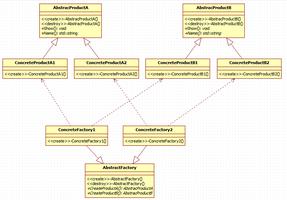Java中常用的加密方式(附多个工具类)

加密方式">一、Java常用加密方式
- Base64加密算法(编码方式)
- MD5加密(消息摘要算法,验证信息完整性)
- 对称加密算法
- 非对称加密算法
- 数字签名算法
- 数字证书
二、分类
按加密算法是否需要key被分为两类:
- 不基于key的有: Base64算法、MD5
- 基于key的有: 对称加密算法、非对称加密算法、数字签名算法、数字证书、HMAC、RC4(对称加密)
按加密算法是否可逆被分为两类:
- 单向加密算法(不可解密):MD5、SHA、HMAC
- 非单项加密算法(可解密):BASE64、对称加密算法、非对称加密算法、数字签名算法、数字证书
三、算法介绍
1.对称加密
对称加密是最快速、最简单的一种加密方式,加密(encryption)与解密(decryption)用的是同样的密钥(secret key)。对称加密有很多种算法,由于它效率很高,所以被广泛使用在很多加密协议的核心当中。
对称加密通常使用的是相对较小的密钥,一般小于256 bit。因为密钥越大,加密越强,但加密与解密的过程越慢。如果你只用1 bit来做这个密钥,那黑客们可以先试着用0来解密,不行的话就再用1解;但如果你的密钥有1 MB大,黑客们可能永远也无法破解,但加密和解密的过程要花费很长的时间。密钥的大小既要照顾到安全性,也要照顾到效率,是一个trade-off。
DES(Data Encryption Standard)和TripleDES是对称加密的两种实现。
DES和TripleDES基本算法一致,只是TripleDES算法提供的key位数更多,加密可靠性更高。
DES使用的密钥key为8字节,初始向量IV也是8字节。
TripleDES使用24字节的key,初始向量IV也是8字节。
两种算法都是以8字节为一个块进行加密,一个数据块一个数据块的加密,一个8字节的明文加密后的密文也是8字节。如果明文长度不为8字节的整数倍,添加值为0的字节凑满8字节整数倍。所以加密后的密文长度一定为8字节的整数倍
下面举个例子:
import java.security.InvalidKeyException;import java.security.Key;
import java.security.NoSuchAlgorithmException;
import java.security.SecureRandom;
import java.security.spec.InvalidKeySpecException;
import javax.crypto.Cipher;
import javax.crypto.SecretKey;
import javax.crypto.SecretKeyFactory;
import javax.crypto.spec.DESKeySpec;
import org.apache.commons.codec.binary.Base64;
public class DESDemo {
// 算法名称
public static final String KEY_ALGORITHM = "DES";
// 算法名称/加密模式/填充方式
// DES共有四种工作模式-->>ECB:电子密码本模式、CBC:加密分组链接模式、CFB:加密反馈模式、OFB:输出反馈模式
public static final String CIPHER_ALGORITHM = "DES/ECB/NoPadding";
/**
*
* 生成密钥key对象
*
* @param KeyStr
* 密钥字符串
* @return 密钥对象
* @throws InvalidKeyException
* @throws NoSuchAlgorithmException
* @throws InvalidKeySpecException
* @throws Exception
*/
private static SecretKey keyGenerator(String keyStr) throws Exception {
byte input[] = HexString2Bytes(keyStr);
DESKeySpec desKey = new DESKeySpec(input);
// 创建一个密匙工厂,然后用它把DESKeySpec转换成
SecretKeyFactory keyFactory = SecretKeyFactory.getInstance("DES");
SecretKey securekey = keyFactory.generateSecret(desKey);
return securekey;
}
private static int parse(char c) {
if (c >= 'a')
return (c - 'a' + 10) & 0x0f;
if (c >= 'A')
return (c - 'A' + 10) & 0x0f;
return (c - '0') & 0x0f;
}
// 从十六进制字符串到字节数组转换
public static byte[] HexString2Bytes(String hexstr) {
byte[] b = new byte[hexstr.length() / 2];
int j = 0;
for (int i = 0; i < b.length; i++) {
char c0 = hexstr.charAt(j++);
char c1 = hexstr.charAt(j++);
b[i] = (byte) ((parse(c0) << 4) | parse(c1));
}
return b;
}
/**
* 加密数据
*
* @param data
* 待加密数据
* @param key
* 密钥
* @return 加密后的数据
*/
public static String encrypt(String data, String key) throws Exception {
Key deskey = keyGenerator(key);
// 实例化Cipher对象,它用于完成实际的加密操作
Cipher cipher = Cipher.getInstance(CIPHER_ALGORITHM);
SecureRandom random = new SecureRandom();
// 初始化Cipher对象,设置为加密模式
cipher.init(Cipher.ENCRYPT_MODE, deskey, random);
byte[] results = cipher.doFinal(data.getBytes());
// 该部分是为了与加解密在线测试网站(http://tripledes.online-domain-tools.com/)的十六进制结果进行核对
for (int i = 0; i < results.length; i++) {
System.out.print(results[i] + " ");
}
System.out.println();
// 执行加密操作。加密后的结果通常都会用Base64编码进行传输
return Base64.encodeBase64String(results);
}
/**
* 解密数据
*
* @param data
* 待解密数据
* @param key
* 密钥
* @return 解密后的数据
*/
public static String decrypt(String data, String key) throws Exception {
Key deskey = keyGenerator(key);
Cipher cipher = Cipher.getInstance(CIPHER_ALGORITHM);
// 初始化Cipher对象,设置为解密模式
cipher.init(Cipher.DECRYPT_MODE, deskey);
// 执行解密操作
return new String(cipher.doFinal(Base64.decodeBase64(data)));
}
public static void main(String[] args) throws Exception {
String source = "helloittx";
System.out.println("原文: " + source);
String key = "A1B2C3D4E5F60708";
String encryptData = encrypt(source, key);
System.out.println("加密后: " + encryptData);
String decryptData = decrypt(encryptData, key);
System.out.println("解密后: " + decryptData);
}
}
2.非对称加密
非对称加密为数据的加密与解密提供了一个非常安全的方法,它使用了一对密钥,公钥(public key)和私钥(private key)。私钥只能由一方安全保管,不能外泄,而公钥则可以发给任何请求它的人。非对称加密使用这对密钥中的一个进行加密,而解密则需要另一个密钥。比如,你向银行请求公钥,银行将公钥发给你,你使用公钥对消息加密,那么只有私钥的持有人–银行才能对你的消息解密。与对称加密不同的是,银行不需要将私钥通过网络发送出去,因此安全性大大提高。
目前最常用的非对称加密算法是RSA算法,是Rivest, Shamir, 和Adleman于1978年发明,他们那时都是在MIT。请看下面的例子:
import java.io.FileInputStream;import java.io.FileOutputStream;
import java.io.ObjectInputStream;
import java.io.ObjectOutputStream;
import java.math.BigInteger;
import java.security.Key;
import java.security.KeyFactory;
import java.security.KeyPair;
import java.security.KeyPairGenerator;
import java.security.SecureRandom;
import java.security.spec.RSAPrivateCrtKeySpec;
import java.security.spec.RSAPublicKeySpec;
import javax.crypto.Cipher;
import com.lxh.rsatest.HexUtil;
import Decoder.BASE64Decoder;
import Decoder.BASE64Encoder;
public class RSAEncrypt {
/** 指定加密算法为DESede */
private static String ALGORITHM = "RSA";
/** 指定key的大小 */
private static int KEYSIZE = 1024;
/** 指定公钥存放文件 */
private static String PUBLIC_KEY_FILE = "public.keystore";
/** 指定私钥存放文件 */
private static String PRIVATE_KEY_FILE = "private.keystore";
/**
* 生成密钥对
*/
private static void generateKeyPair() throws Exception {
/** RSA算法要求有一个可信任的随机数源 */
SecureRandom sr = new SecureRandom();
/** 为RSA算法创建一个KeyPairGenerator对象 */
KeyPairGenerator kpg = KeyPairGenerator.getInstance(ALGORITHM);
/** 利用上面的随机数据源初始化这个KeyPairGenerator对象 */
kpg.initialize(KEYSIZE, sr);
/** 生成密匙对 */
KeyPair kp = kpg.generateKeyPair();
/** 得到公钥 */
Key publicKey = kp.getPublic();
/** 得到私钥 */
Key privateKey = kp.getPrivate();
/** 用对象流将生成的密钥写入文件 */
ObjectOutputStream oos1 = new ObjectOutputStream(new FileOutputStream(PUBLIC_KEY_FILE));
ObjectOutputStream oos2 = new ObjectOutputStream(new FileOutputStream(PRIVATE_KEY_FILE));
oos1.writeObject(publicKey);
oos2.writeObject(privateKey);
/** 清空缓存,关闭文件输出流 */
oos1.close();
oos2.close();
}
/**
* 生成密钥对字符串
*/
private static void generateKeyPairString() throws Exception {
/** RSA算法要求有一个可信任的随机数源 */
SecureRandom sr = new SecureRandom();
/** 为RSA算法创建一个KeyPairGenerator对象 */
KeyPairGenerator kpg = KeyPairGenerator.getInstance(ALGORITHM);
/** 利用上面的随机数据源初始化这个KeyPairGenerator对象 */
kpg.initialize(KEYSIZE, sr);
/** 生成密匙对 */
KeyPair kp = kpg.generateKeyPair();
/** 得到公钥 */
Key publicKey = kp.getPublic();
/** 得到私钥 */
Key privateKey = kp.getPrivate();
/** 用字符串将生成的密钥写入文件 */
String algorithm = publicKey.getAlgorithm(); // 获取算法
KeyFactory keyFact = KeyFactory.getInstance(algorithm);
BigInteger prime = null;
BigInteger exponent = null;
RSAPublicKeySpec keySpec = (RSAPublicKeySpec) keyFact.getKeySpec(publicKey, RSAPublicKeySpec.class);
prime = keySpec.getModulus();
exponent = keySpec.getPublicExponent();
System.out.println("公钥模量:" + HexUtil.bytes2Hex(prime.toByteArray()));
System.out.println("公钥指数:" + HexUtil.bytes2Hex(exponent.toByteArray()));
System.out.println(privateKey.getAlgorithm());
RSAPrivateCrtKeySpec privateKeySpec = (RSAPrivateCrtKeySpec) keyFact.getKeySpec(privateKey,
RSAPrivateCrtKeySpec.class);
BigInteger privateModulus = privateKeySpec.getModulus();
BigInteger privateExponent = privateKeySpec.getPrivateExponent();
System.out.println("私钥模量:" + HexUtil.bytes2Hex(privateModulus.toByteArray()));
System.out.println("私钥指数:" + HexUtil.bytes2Hex(privateExponent.toByteArray()));
}
/**
* 加密方法 source: 源数据
*/
public static String encrypt(String source) throws Exception {
generateKeyPair();
/** 将文件中的公钥对象读出 */
ObjectInputStream ois = new ObjectInputStream(new FileInputStream(PUBLIC_KEY_FILE));
Key key = (Key) ois.readObject();
ois.close();
String algorithm = key.getAlgorithm(); // 获取算法
KeyFactory keyFact = KeyFactory.getInstance(algorithm);
BigInteger prime = null;
BigInteger exponent = null;
if ("RSA".equals(algorithm)) { // 如果是RSA加密
RSAPublicKeySpec keySpec = (RSAPublicKeySpec) keyFact.getKeySpec(key, RSAPublicKeySpec.class);
prime = keySpec.getModulus();
exponent = keySpec.getPublicExponent();
// System.out.println("公钥模量:" + HexUtil.bytes2Hex(prime.toByteArray()));
// System.out.println("公钥指数:" + HexUtil.bytes2Hex(exponent.toByteArray()));
}
/** 得到Cipher对象来实现对源数据的RSA加密 */
Cipher cipher = Cipher.getInstance(ALGORITHM);
cipher.init(Cipher.ENCRYPT_MODE, key);
byte[] b = source.getBytes();
/** 执行加密操作 */
byte[] b1 = cipher.doFinal(b);
BASE64Encoder encoder = new BASE64Encoder();
return encoder.encode(b1);
}
/**
* 解密算法 cryptograph:密文
*/
public static String decrypt(String cryptograph) throws Exception {
/** 将文件中的私钥对象读出 */
ObjectInputStream ois = new ObjectInputStream(new FileInputStream(PRIVATE_KEY_FILE));
Key key = (Key) ois.readObject();
String algorithm = key.getAlgorithm(); // 获取算法
KeyFactory keyFact = KeyFactory.getInstance(algorithm);
RSAPrivateCrtKeySpec privateKeySpec = (RSAPrivateCrtKeySpec) keyFact.getKeySpec(key,
RSAPrivateCrtKeySpec.class);
BigInteger privateModulus = privateKeySpec.getModulus();
BigInteger privateExponent = privateKeySpec.getPrivateExponent();
// System.out.println("私钥模量:" + HexUtil.bytes2Hex(privateModulus.toByteArray()));
// System.out.println("私钥指数:" + HexUtil.bytes2Hex(privateExponent.toByteArray()));
/** 得到Cipher对象对已用公钥加密的数据进行RSA解密 */
Cipher cipher = Cipher.getInstance(ALGORITHM);
cipher.init(Cipher.DECRYPT_MODE, key);
BASE64Decoder decoder = new BASE64Decoder();
byte[] b1 = decoder.decodeBuffer(cryptograph);
/** 执行解密操作 */
byte[] b = cipher.doFinal(b1);
return new String(b);
}
public static void main(String[] args) throws Exception {
generateKeyPair(); //生成文件形式公钥和私钥
//generateKeyPairString();//生成字符串形式公钥和私钥
String source = "非对称加密RSA";// 要加密的字符串
String cryptograph = encrypt(source);// 生成的密文
String hexCrypt = HexUtil.bytes2Hex(cryptograph.getBytes(), false);
System.out.println("生成的密文--->" + hexCrypt);
String target = decrypt(HexUtil.hex2String(hexCrypt));// 解密密文
System.out.println("解密密文--->" + target);
}
}
虽然非对称加密很安全,但是和对称加密比起来,它非常的慢,所以我们还是要用对称加密来传送消息,但对称加密所使用的密钥我们可以通过非对称加密的方式发送出去。
(1) 对称加密加密与解密使用的是同样的密钥,所以速度快,但由于需要将密钥在网络传输,所以安全性不高。
(2) 非对称加密使用了一对密钥,公钥与私钥,所以安全性高,但加密与解密速度慢。
(3) 解决的办法是将对称加密的密钥使用非对称加密的公钥进行加密,然后发送出去,接收方使用私钥进行解密得到对称加密的密钥,然后双方可以使用对称加密来进行沟通。
3.Base64编码
Base 64 Encoding有什么用?举个简单的例子,你使用SMTP协议 (Simple Mail Transfer Protocol 简单邮件传输协议)来发送邮件。因为这个协议是基于文本的协议,所以如果邮件中包含一幅图片,我们知道图片的存储格式是二进制数据(binary data),而非文本格式,我们必须将二进制的数据编码成文本格式,这时候Base 64 Encoding就派上用场了。
public void testJDKBase64(){ String encoderStr = java.util.Base64.getEncoder().encodeToString(s.getBytes());
System.out.println("encode :"+encoderStr);
String decodeStr = new String(java.util.Base64.getDecoder().decode(encoderStr));
System.out.println("decodeStr :"+decodeStr);
}
public void testCodecBase64(){
String encoderStr = org.apache.commons.codec.binary.Base64.encodeBase64String(s.getBytes());
System.out.println("encode :"+encoderStr);
String decodeStr = new String(org.apache.commons.codec.binary.Base64.decodeBase64(encoderStr));
System.out.println("decodeStr :"+decodeStr);
}
附工具类
package com.hl.bluetooth.util;import org.springframework.boot.system.ApplicationHome;
import org.springframework.stereotype.Component;
import org.springframework.web.multipart.MultipartFile;
import sun.misc.BASE64Decoder;
import sun.misc.BASE64Encoder;
import java.io.*;
import java.util.Objects;
/**
* @DateL 2021/11/16 15:09
* @ClassName: FileUtils
**/
@Component
public class FileUtils {
public static File multipartFileToFile(MultipartFile multipartFile) {
File file = new File(Objects.requireNonNull(multipartFile.getOriginalFilename()));
try {
InputStream ins = null;
ins = multipartFile.getInputStream();
OutputStream os = new FileOutputStream(file);
int bytesRead = 0;
byte[] buffer = new byte[8192];
while ((bytesRead = ins.read(buffer, 0, 8192)) != -1) {
os.write(buffer, 0, bytesRead);
}
os.close();
ins.close();
} catch (Exception e) {
e.printStackTrace();
}
return file;
}
/**
* 图片转化成base64字符串
*
*/
public static String getImageStr(String imgPath) {
InputStream in = null;
byte[] data = null;
String encode = null;
// 对字节数组Base64编码
BASE64Encoder encoder = new BASE64Encoder();
try {
// 读取图片字节数组
in = new FileInputStream(imgPath);
data = new byte[in.available()];
in.read(data);
encode = encoder.encode(data);
} catch (IOException e) {
e.printStackTrace();
} finally {
try {
in.close();
} catch (IOException e) {
e.printStackTrace();
}
}
return encode;
}
/**
* base64字符串转化成图片
*
* @param imgData 图片编码
*/
public static String generateImage(String imgData, String fileName) {
if (imgData == null) {
// 图像数据为空
return "null";
}
ApplicationHome applicationHome = new ApplicationHome(FileUtils.class);
File source = applicationHome.getSource();
String dirPath = source.getParentFile().toString() + "/upload";
BASE64Decoder decoder = new BASE64Decoder();
File dir = new File(dirPath);
if (!dir.exists()){
dir.mkdirs();
}
File file = new File(dirPath+"/"+fileName);
if (file.exists()){
file.delete();
}
try {
// Base64解码
byte[] b = decoder.decodeBuffer(imgData);
for (int i = 0; i < b.length; ++i) {
// 调整异常数据
if (b[i] < 0) {
b[i] += 256;
}
}
OutputStream out = new FileOutputStream(dirPath+"\\"+fileName);
out.write(b);
out.flush();
out.close();
return dirPath+"\\"+fileName;
} catch (Exception e) {
e.printStackTrace();
return "null";
}
}
}
4.MD5加密
Message Digest Algorithm MD5(中文名为消息摘要算法第五版)为计算机安全领域广泛使用的一种散列函数,用以提供消息的完整性保护。该算法的文件号为RFC 1321(R.Rivest,MIT Laboratory for Computer Science and RSA Data Security Inc. April 1992).
MD5的全称是Message-Digest Algorithm 5(信息-摘要算法),在90年代初由MIT Laboratory for Computer Science和RSA Data Security Inc的Ronald L. Rivest开发出来,经MD2、MD3和MD4发展而来。
MD5用于确保信息传输完整一致。是计算机广泛使用的杂凑算法之一(又译摘要算法、哈希算法),主流编程语言普遍已有MD5实现。将数据(如汉字)运算为另一固定长度值,是杂凑算法的基础原理,MD5的前身有MD2、MD3和MD4。
MD5的作用是让大容量信息在用数字签名软件签署私人密钥前被”压缩”成一种保密的格式(就是把一个任意长度的字节串变换成一定长的十六进制数字串)。
import java.security.MessageDigest;import java.security.NoSuchAlgorithmException;
/**
* Java消息摘要算法 MD5 工具类,其实其他摘要算法的实现也类似
*/
public class MD5Util {
/**
* 对文本执行 md5 摘要加密, 此算法与 mysql,JavaScript生成的md5摘要进行过一致性对比.
* @param plainText
* @return 返回值中的字母为小写
*/
public static String md5(String plainText) {
if (null == plainText) {
plainText = "";
}
String MD5Str = "";
try {
// JDK 6 支持以下6种消息摘要算法,不区分大小写
// md5,sha(sha-1),md2,sha-256,sha-384,sha-512
MessageDigest md = MessageDigest.getInstance("MD5");
md.update(plainText.getBytes());
byte b[] = md.digest();
int i;
StringBuilder builder = new StringBuilder(32);
for (int offset = 0; offset < b.length; offset++) {
i = b[offset];
if (i < 0)
i += 256;
if (i < 16)
builder.append("0");
builder.append(Integer.toHexString(i));
}
MD5Str = builder.toString();
// LogUtil.println("result: " + buf.toString());// 32位的加密
} catch (NoSuchAlgorithmException e) {
e.printStackTrace();
}
return MD5Str;
}
// 一个简版测试
public static void main(String[] args) {
String m1 = md5("1");
String m2 = md5(m1);
/* 输出为
* m1=c4ca4238a0b923820dcc509a6f75849b
* m2=28c8edde3d61a0411511d3b1866f0636
*/
System.out.println("m1="+m1);
System.out.println("m2="+m2);
}
}
通常我们不直接使用上述MD5加密。通常将MD5产生的字节数组交给Base64再加密一把,得到相应的字符串。
5.数字签名算法
签名:就有安全性,抗否认性
数字签名:带有密钥(公钥,私钥)的消息摘要算法
作用:
1. 验证数据的完整性
2. 认证数据来源
3. 抗否认
数字签名遵循:私钥签名,公钥验证
常用的数字签名算法:RSA,DSA,ECDSA
RSA介绍:
是经典算法,是目前为止使用最广泛的数字签名算法。
RSA数字签名算法的密钥实现与RSA的加密算法是一样的,算法的名称都叫RSA。密钥的产生和转换都是一样的。
RSA数字签名算法主要包括MD和SHA两类。
import java.security.KeyFactory;import java.security.KeyPair;
import java.security.KeyPairGenerator;
import java.security.PrivateKey;
import java.security.PublicKey;
import java.security.Signature;
import java.security.interfaces.RSAPrivateKey;
import java.security.interfaces.RSAPublicKey;
import java.security.spec.PKCS8EncodedKeySpec;
import java.security.spec.X509EncodedKeySpec;
import org.apache.commons.codec.binary.Hex;
public class RSATest {
public static final String src = "hello world";
public static void main(String[] args) {
jdkRSA();
}
/**
* 说明: 用java的jdk里面相关方法实现rsa的签名及签名验证
*/
public static void jdkRSA() {
try {
// 1.初始化密钥
KeyPairGenerator keyPairGenerator = KeyPairGenerator
.getInstance("RSA");
//设置KEY的长度
keyPairGenerator.initialize(512);
KeyPair keyPair = keyPairGenerator.generateKeyPair();
//得到公钥
RSAPublicKey rsaPublicKey = (RSAPublicKey) keyPair.getPublic();
//得到私钥
RSAPrivateKey rsaPrivateKey = (RSAPrivateKey) keyPair.getPrivate();
// 2.进行签名
//用私钥进行签名
PKCS8EncodedKeySpec pkcs8EncodedKeySpec = new PKCS8EncodedKeySpec(
rsaPrivateKey.getEncoded());
KeyFactory keyFactory = KeyFactory.getInstance("RSA");
//构造一个privateKey
PrivateKey privateKey = keyFactory
.generatePrivate(pkcs8EncodedKeySpec);
//声明签名的对象
Signature signature = Signature.getInstance("MD5withRSA");
signature.initSign(privateKey);
signature.update(src.getBytes());
//进行签名
byte[] result = signature.sign();
System.out.println("jdk rsa sign:" + Hex.encodeHexString(result));
// 3.验证签名
//用公钥进行验证签名
X509EncodedKeySpec x509EncodedKeySpec = new X509EncodedKeySpec(
rsaPublicKey.getEncoded());
keyFactory = KeyFactory.getInstance("RSA");
//构造一个publicKey
PublicKey publicKey = keyFactory.generatePublic(x509EncodedKeySpec);
//声明签名对象
signature = Signature.getInstance("MD5withRSA");
signature.initVerify(publicKey);
signature.update(src.getBytes());
//验证签名
boolean bool = signature.verify(result);
System.out.println("jdk rsa verify:" + bool);
} catch (Exception e) {
System.out.println(e.toString());
}
}
}
四、应用场景
Base64应用场景:图片转码(应用于邮件,img标签,http加密)
MD5应用场景:密码加密、imei加密、文件校验
非对称加密:电商订单付款、银行相关业务
五、附多个工具类
AES
package com.hl.bluetooth.util;import org.apache.commons.lang3.StringUtils;
import org.apache.tomcat.util.codec.binary.Base64;
import javax.crypto.Cipher;
import javax.crypto.spec.IvParameterSpec;
import javax.crypto.spec.SecretKeySpec;
public class AesEncryptUtil {
//使用AES-128-CBC加密模式,key需要为16位,key和iv可以相同!
private final static String KEY = "ABCDEF1234432100";
private final static String IV = "43211234DCAB6789";
/**
* 加密方法
* @param data 要加密的数据
* @param key 加密key
* @param iv 加密iv
* @return 加密的结果
* @throws Exception
*/
public static String encrypt(String data, String key, String iv) throws Exception {
try {
Cipher cipher = Cipher.getInstance("AES/CBC/NoPadding");//"算法/模式/补码方式"NoPadding PkcsPadding
int blockSize = cipher.getBlockSize();
byte[] dataBytes = data.getBytes();
int plaintextLength = dataBytes.length;
if (plaintextLength % blockSize != 0) {
plaintextLength = plaintextLength + (blockSize - (plaintextLength % blockSize));
}
byte[] plaintext = new byte[plaintextLength];
System.arraycopy(dataBytes, 0, plaintext, 0, dataBytes.length);
SecretKeySpec keyspec = new SecretKeySpec(key.getBytes(), "AES");
IvParameterSpec ivspec = new IvParameterSpec(iv.getBytes());
cipher.init(Cipher.ENCRYPT_MODE, keyspec, ivspec);
byte[] encrypted = cipher.doFinal(plaintext);
return new Base64().encodeToString(encrypted);
} catch (Exception e) {
e.printStackTrace();
return null;
}
}
/**
* 解密方法
* @param data 要解密的数据
* @param key 解密key
* @param iv 解密iv
* @return 解密的结果
* @throws Exception
*/
public static String desEncrypt(String data, String key, String iv) throws Exception {
try {
// byte[] encrypted1 = new Base64().decode(data);
byte[] encrypted1 = parseHexStr2Byte(data);
// Cipher cipher = Cipher.getInstance("AES/CBC/NoPadding");
Cipher cipher = Cipher.getInstance("AES/CBC/PKCS5Padding");
SecretKeySpec keyspec = new SecretKeySpec(key.getBytes(), "AES");
IvParameterSpec ivspec = new IvParameterSpec(iv.getBytes());
cipher.init(Cipher.DECRYPT_MODE, keyspec, ivspec);
byte[] original = cipher.doFinal(encrypted1);
String originalString = new String(original);
return originalString;
} catch (Exception e) {
e.printStackTrace();
return null;
}
}
/**
* 使用默认的key和iv加密
* @param data
* @return
* @throws Exception
*/
public static String encrypt(String data) throws Exception {
return encrypt(data, KEY, IV);
}
/**
* 使用默认的key和iv解密
* @param data
* @return
* @throws Exception
*/
public static String desEncrypt(String data) throws Exception {
if (StringUtils.isEmpty(data)) {
return null;
}
return desEncrypt(data, KEY, IV);
}
/**
* @Author wdc
* @Description 16进制转byte数组
* @Date 2021/4/19 11:14
* @Param [hexStr]
* @return byte[]
**/
public static byte[] parseHexStr2Byte(String hexStr) {
if (hexStr.length() < 1)
return null;
byte[] result = new byte[hexStr.length()/2];
for (int i = 0;i< hexStr.length()/2; i++) {
int high = Integer.parseInt(hexStr.substring(i*2, i*2+1), 16);
int low = Integer.parseInt(hexStr.substring(i*2+1, i*2+2), 16);
result[i] = (byte) (high * 16 + low);
}
return result;
}
public static void main(String[] args) {
// String test = "{'admin','admin'}";
//// String test =new String(test1.getBytes(),"UTF-8");
// String data = null;
// data = AesEncryptUtil.encrypt(test);
// System.out.println("数据:"+test);
// System.out.println("加密:"+data);
// String jiemi = AesEncryptUtil.desEncrypt(data);
// System.out.println("解密:"+jiemi);
}
}
base64
package com.sgitg.util;import java.io.UnsupportedEncodingException;
import org.springframework.util.Base64Utils;
public class Base64Util {
/**
* 解码base64编码的字符串
*
* @param source
* @return
* @throws UnsupportedEncodingException
*/
public static String decodeFromString(String source) {
String str = "";
try {
byte[] bt = Base64Utils.decodeFromString(source);
str = new String(bt, "utf-8");
} catch (UnsupportedEncodingException e) {
e.printStackTrace(); // To change body of catch statement use File |
// Settings | File Templates.
}
return str;
}
/**
* 对字符串进行base64编码
*
* @param source
* @return
* @throws UnsupportedEncodingException
*/
public static String encodeToString(String source) {
byte[] bt = new byte[0];
try {
bt = source.getBytes("utf-8");
} catch (UnsupportedEncodingException e) {
e.printStackTrace(); // To change body of catch statement use File |
// Settings | File Templates.
}
return Base64Utils.encodeToString(bt);
}
}
EncryptUtils (编码集合)
* 1、Base64编码
* 1、AES、DES可逆算法
* 2、md5,Hex,Sha不可逆算法加密
package com.sgitg.util;import org.apache.commons.codec.digest.DigestUtils;
import javax.crypto.Cipher;
import javax.crypto.KeyGenerator;
import javax.crypto.SecretKey;
import javax.crypto.spec.SecretKeySpec;
import java.io.File;
import java.io.FileInputStream;
import java.io.FileNotFoundException;
import java.io.IOException;
import java.nio.MappedByteBuffer;
import java.nio.channels.FileChannel;
import java.security.MessageDigest;
import java.security.NoSuchAlgorithmException;
import java.security.SecureRandom;
import java.util.Base64;
import java.util.zip.CRC32;
/**
* 数据加密
* 继承org.apache.commons.codec.digest.DigestUtils
* 1、Base64编码
* 1、AES、DES可逆算法
* 2、md5,Hex,Sha不可逆算法加密
*
* @author liuyadu
*/
public class EncryptUtils extends DigestUtils {
/**
* 计算大文件 md5获取getMD5(); SHA1获取getSha1() CRC32获取 getCRC32()
*/
private static char[] hexDigits = {'0', '1', '2', '3', '4', '5', '6', '7', '8', '9', 'a', 'b', 'c', 'd', 'e',
'f'};
// 测试
public static void main(String[] args) {
String en = encryptDES("hahahaha", "yaer");
String de = decryptDES("kzWPLLyAsDeBr84lL2COsA==", "yaer");
System.out.println(de);
System.out.println(en);
en = encryptAES("hahahaha", "yaer");
de = decryptAES("FBC82B89BAA1FBBDF3AE086A09D57E7C", "yaer");
System.out.println(de);
System.out.println(en);
}
/**
* AES加密(可逆)
*
* @param plainText 明文
* @param privateKey 密钥
* @return
* @throws NoSuchAlgorithmException
*/
public static String encryptAES(String plainText, String privateKey) {
try {
KeyGenerator kgen = KeyGenerator.getInstance("AES");
SecureRandom random = SecureRandom.getInstance("SHA1PRNG");
random.setSeed(privateKey.getBytes());
kgen.init(128, random);
SecretKey secretKey = kgen.generateKey();
byte[] enCodeFormat = secretKey.getEncoded();
SecretKeySpec secretKeySpec = new SecretKeySpec(enCodeFormat, "AES");
Cipher cipher = Cipher.getInstance("AES");
byte[] byteContent = plainText.getBytes("utf-8");
cipher.init(Cipher.ENCRYPT_MODE, secretKeySpec);
byte[] byteRresult = cipher.doFinal(byteContent);
String sb = new String("");
for (int i = 0; i < byteRresult.length; i++) {
String hex = Integer.toHexString(byteRresult[i] & 0xFF);
if (hex.length() == 1) {
hex = '0' + hex;
}
sb = sb.concat(hex.toUpperCase());
}
return sb;
} catch (Exception e) {
return null;
}
}
/**
* AES解密
*
* @param cipherText 密文
* @param privateKey 密钥
* @return
* @throws Exception
*/
public static String decryptAES(String cipherText, String privateKey) {
try {
if (cipherText.length() < 1) {
return null;
}
byte[] byteRresult = new byte[cipherText.length() / 2];
for (int i = 0; i < cipherText.length() / 2; i++) {
int high = Integer.parseInt(cipherText.substring(i * 2, i * 2 + 1), 16);
int low = Integer.parseInt(cipherText.substring(i * 2 + 1, i * 2 + 2), 16);
byteRresult[i] = (byte) (high * 16 + low);
}
KeyGenerator kgen = KeyGenerator.getInstance("AES");
SecureRandom random = SecureRandom.getInstance("SHA1PRNG");
random.setSeed(privateKey.getBytes());
kgen.init(128, random);
SecretKey secretKey = kgen.generateKey();
byte[] enCodeFormat = secretKey.getEncoded();
SecretKeySpec secretKeySpec = new SecretKeySpec(enCodeFormat, "AES");
Cipher cipher = Cipher.getInstance("AES");
cipher.init(Cipher.DECRYPT_MODE, secretKeySpec);
byte[] result = cipher.doFinal(byteRresult);
return new String(result);
} catch (Exception e) {
return null;
}
}
/**
* 加密DES(可逆)
*
* @param plainText 明文
* @param privateKey 密钥
* @return
*/
public static String encryptDES(String plainText, String privateKey) {
try {
KeyGenerator keygen = KeyGenerator.getInstance("DES");
SecureRandom secureRandom = SecureRandom.getInstance("SHA1PRNG");
secureRandom.setSeed(privateKey.getBytes());
keygen.init(56, secureRandom);
SecretKey secretKey = keygen.generateKey();
Cipher cipher = Cipher.getInstance("DES/ECB/PKCS5Padding");
cipher.init(Cipher.ENCRYPT_MODE, secretKey);
byte[] cipherBytes = cipher.doFinal(plainText.getBytes("utf-8"));
byte[] plainTextBytes = Base64.getEncoder().encode(cipherBytes);
return new String(plainTextBytes, "utf-8");
} catch (Exception e) {
e.printStackTrace();
return null;
}
}
/**
* 解密DES
*
* @param cipherText 密文
* @param privateKey 密钥
* @return
*/
public static String decryptDES(String cipherText, String privateKey) {
try {
KeyGenerator keygen = KeyGenerator.getInstance("DES");
SecureRandom secureRandom = SecureRandom.getInstance("SHA1PRNG");
secureRandom.setSeed(privateKey.getBytes());
keygen.init(56, secureRandom);
SecretKey secretKey = keygen.generateKey();
Cipher cipher = Cipher.getInstance("DES/ECB/PKCS5Padding");
cipher.init(Cipher.DECRYPT_MODE, secretKey);
byte[] cipherTextBytes = Base64.getDecoder().decode(cipherText.getBytes("utf-8"));
byte[] cipherBytes = cipher.doFinal(cipherTextBytes);
return new String(cipherBytes, "utf-8");
} catch (Exception e) {
e.printStackTrace();
return null;
}
}
/**
* 获取文件md5值
*
* @return md5串
*/
public static String md5(File file) {
try {
//encrypt
MessageDigest messagedigest = MessageDigest.getInstance("MD5");
FileInputStream in = new FileInputStream(file);
FileChannel ch = in.getChannel();
MappedByteBuffer byteBuffer = ch.map(FileChannel.MapMode.READ_ONLY, 0, file.length());
messagedigest.update(byteBuffer);
return bufferToHex(messagedigest.digest());
} catch (Exception e) {
return null;
}
}
/***
* 获取文件SHA1值
*
* @return String 适用于上G大的文件
*/
public static String sha1(File file) {
try {
MessageDigest messagedigest = MessageDigest.getInstance("SHA-1");
FileInputStream in = new FileInputStream(file);
FileChannel ch = in.getChannel();
MappedByteBuffer byteBuffer = ch.map(FileChannel.MapMode.READ_ONLY, 0, file.length());
messagedigest.update(byteBuffer);
return bufferToHex(messagedigest.digest());
} catch (Exception e) {
return null;
}
}
/**
* 获取文件SHA256值
*
* @return String
*/
public static String sha256(File file) {
try {
MessageDigest messagedigest = MessageDigest.getInstance("SHA-256");
FileInputStream in = new FileInputStream(file);
FileChannel ch = in.getChannel();
MappedByteBuffer byteBuffer = ch.map(FileChannel.MapMode.READ_ONLY, 0, file.length());
messagedigest.update(byteBuffer);
return bufferToHex(messagedigest.digest());
} catch (Exception e) {
return null;
}
}
/**
* 获取文件CRC32码
*
* @return String
*/
public static String crc32(File file) {
CRC32 crc32 = new CRC32();
// MessageDigest.get
FileInputStream fileInputStream = null;
try {
fileInputStream = new FileInputStream(file);
byte[] buffer = new byte[8192];
int length;
while ((length = fileInputStream.read(buffer)) != -1) {
crc32.update(buffer, 0, length);
}
return crc32.getValue() + "";
} catch (FileNotFoundException e) {
e.printStackTrace();
return null;
} catch (IOException e) {
e.printStackTrace();
return null;
} finally {
try {
if (fileInputStream != null) {
fileInputStream.close();
}
} catch (IOException e) {
e.printStackTrace();
}
}
}
/**
* 计算二进制数据
*
* @return
*/
private static String bufferToHex(byte bytes[]) {
return bufferToHex(bytes, 0, bytes.length);
}
private static String bufferToHex(byte bytes[], int m, int n) {
StringBuffer stringbuffer = new StringBuffer(2 * n);
int k = m + n;
for (int l = m; l < k; l++) {
appendHexPair(bytes[l], stringbuffer);
}
return stringbuffer.toString();
}
private static void appendHexPair(byte bt, StringBuffer stringbuffer) {
char c0 = hexDigits[(bt & 0xf0) >> 4];
char c1 = hexDigits[bt & 0xf];
stringbuffer.append(c0);
stringbuffer.append(c1);
}
}
以上是 Java中常用的加密方式(附多个工具类) 的全部内容, 来源链接: utcz.com/z/394077.html







